 1955 DeSoto Firedome II Four-Door Sedan Dimensions, Size & Specs
1955 DeSoto Firedome II Four-Door Sedan Dimensions, Size & SpecsMeasurements of the 1955 DeSoto Firedome II Four-Door Sedan, engineered for optimal performance and comfort
| Dimensions | |
|---|---|
| Length: | 5535 mm217.9 in18.2 ft |
| Width: | 1989 mm78.3 in6.5 ft |
| Height: | 1539 mm60.6 in5.0 ft |
| Ground Clearance: | 160 mm6.3 in0.5 ft |
| Weight Specifications | |
| Curb Weight: | 1764 kg3889 lbs |
The 1955 DeSoto Firedome II Four-Door Sedan is a classic full-size vehicle produced by DeSoto between 1954 and 1955. Known for its stately and robust design, this model is representative of the mid-1950s American sedan style. The Firedome II measures an imposing 5535 mm (218 inches) in length, making it a spacious option for its era and contributing to its comfortable interior room. It spans 1989 mm (78.3 inches) in width, offering ample shoulder room for passengers and enhancing road presence. The vehicle stands 1539 mm (60.6 inches) tall, providing a balanced and moderately low profile for better aerodynamics and a sleek look typical of the period’s luxury sedans.
With a curb weight of 1764 kg (3890 lbs), the Firedome II is built on a sturdy chassis that delivers a solid driving experience, resonating with its durable build and powerful engine options available at the time. Ground clearance is rated at 160 mm (6.3 inches), suitable for diverse road conditions while maintaining a smooth ride quality. This ride height also aids in the vehicle's classic handling dynamics, blending comfort with style.
The Firedome II was designed during a transitional period in automotive design where larger, more stylish sedans were becoming popular among American families and car enthusiasts. Its balanced dimensions place it comfortably among the full-size sedans of the 1950s, offering both practicality and elegance. The combination of its substantial size, moderate height, and weight reflects the engineering priorities of that era, focusing on spaciousness, comfort, and visual appeal.
Whether you're a classic car collector, an automotive historian, or simply interested in vintage car sizes, the 1955 DeSoto Firedome II Four-Door Sedan stands out as a notable example of mid-century American automotive design, blending impressive size with period-specific styling and performance traits.
Discover the standout features that make the 1955 DeSoto Firedome II Four-Door Sedan a leader in its class
Have a question? Please check our knowledgebase first.
The DeSoto Firedome II Four-Door Sedan from 1955 measures 5535 mm (approximately 217.9 inches) in length, 1989 mm (around 78.3 inches) in width, and 1539 mm (about 60.6 inches) in height. These dimensions reflect the design priorities of mid-1950s American sedans, combining a substantial length that offers spacious interior accommodations with a relatively wide body for stability and road presence. The height ensures adequate headroom for passengers without compromising the aerodynamic styling typical of that era.
The 1955 DeSoto Firedome II Four-Door Sedan has a curb weight of approximately 1764 kg (3890 lbs). This considerable weight is reflective of its robust construction and sizeable dimensions typical of 1950s American sedans. The heavier curb weight contributes to a stable and smooth ride on highways, enhancing comfort, but it may also lead to a less nimble driving experience and impact fuel efficiency compared to lighter vehicles. The sturdy build assures durability while giving occupants a sense of solidity and safety.
The DeSoto Firedome II Four-Door Sedan from 1955 offers a ground clearance of about 160 mm (6.3 inches). This moderate ride height is typical for sedans of its time, providing a good balance between ease of entry/exit and sufficient clearance to handle uneven roads or minor obstacles found in urban and suburban environments. While not designed for off-road use, the 160 mm clearance helps protect the undercarriage from road debris and contributes to a comfortable ride on paved surfaces.
Yes, the 1955 DeSoto Firedome II Four-Door Sedan generally fits into a standard residential garage. Standard single-car garages typically measure around 2440 mm to 2743 mm (8 to 9 feet) wide and 4877 mm to 6096 mm (16 to 20 feet) deep. With dimensions of 5535 mm (217.9 inches) in length and 1989 mm (78.3 inches) in width, the Firedome II is on the longer side but still within common garage depth limits. However, due to its width, tight garage spaces or those with storage along the sides may require careful maneuvering to avoid contact with walls or stored items.
Compared to its predecessor, the earlier Firedome models prior to 1954, the 1955 Firedome II Four-Door Sedan saw incremental changes in size that reflected evolving design trends and customer preferences. The 1955 generation grew slightly in length and width to enhance passenger comfort and road presence. The overall dimensions like length (5535 mm) and width (1989 mm) represent a modest increase that allowed for a more spacious cabin and trunk space, while maintaining the sedan's heavy and solid feel. These adjustments improved ride comfort and accommodated larger V8 engines without a drastic shift in vehicle footprint.
In terms of size, the 1955 DeSoto Firedome II Four-Door Sedan is comparable to other American full-size sedans of the mid-1950s. Its length of 5535 mm (217.9 inches) and width of 1989 mm (78.3 inches) are similar to competitors like the Chrysler New Yorker, Dodge Royal, and certain Chevrolet Bel Air models. While some competitors may have had minor variations in dimensions, the Firedome's size places it solidly in the full-size segment, offering generous interior space and a substantial road presence characteristic of that era. It balanced luxury and performance with practical dimensions for family use.
Given its substantial exterior dimensions—5535 mm in length and nearly 2 meters in width—the 1955 DeSoto Firedome II Four-Door Sedan provides spacious passenger accommodations typical of 1950s full-sized American cars. The wide and long body allows for comfortable seating for up to six passengers, with ample legroom and headroom. Cargo space in the trunk is generous as well, suitable for family trips, luggage, or shopping, reflecting the practical usability of sedans in this class. Its size makes it particularly well-suited for comfort rather than compact urban maneuverability.
The 1955 Firedome II Four-Door Sedan retained the classic DeSoto styling cues of the early 1950s but featured some updates in dimensions and design. Compared to earlier models from DeSoto, the Firedome II was slightly larger and heavier, with a longer body that emphasized a more streamlined look and increased interior space. Styling changes also included updated chrome trim, grille design, and tail fins that aligned with the mid-50s automotive aesthetic trends. This generation balanced tradition and modernization in both size and appearance, aiming to appeal to buyers seeking luxury and performance.
The 1955 DeSoto Firedome II was equipped primarily with a FireDome V8 engine, which was known for its power and torque during that era. Engine displacement was typically around 276 cubic inches (4.5 liters), delivering robust performance aimed at providing smooth acceleration and reliable cruising for a large, heavy sedan. This engine helped the car maintain competitive performance relative to its contemporaries, balancing power with the car's substantial weight of about 1764 kg (3890 lbs). While fuel economy was a lesser concern at this time, the Firedome II offered a satisfying driving experience for a family-sized luxury sedan.
With its curb weight of approximately 1764 kg (3890 lbs) and large dimensions, the 1955 DeSoto Firedome II Four-Door Sedan delivers a ride prioritized for comfort and stability rather than agile handling. The relatively heavy build and wide stance result in smooth cruising and reduced road vibrations, making it ideal for long drives and highway use. However, the trade-off is less nimbleness in tight turns or rapid maneuvers compared to smaller, lighter cars. Suspension tuning and ride height of 160 mm (6.3 inches) contribute to a plush ride quality that was typical for American sedans of the mid-1950s.
Discover similar sized cars.
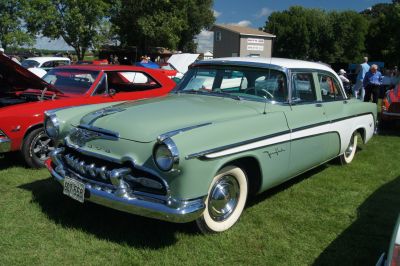
| Production: | 1954-1955 |
|---|---|
| Model Year: | 1955 |
| Length: | 5535 mm217.9 in |
| Width: | 1989 mm78.3 in |
| Height: | 1539 mm60.6 in |

| Production: | 1955-1956 |
|---|---|
| Model Year: | 1956 |
| Length: | 5535 mm217.9 in |
| Width: | 1989 mm78.3 in |
| Height: | 1539 mm60.6 in |
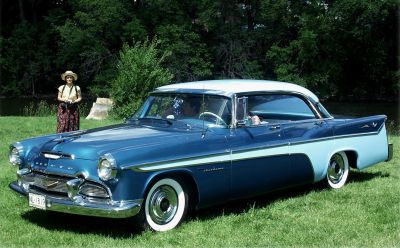
| Production: | 1955-1956 |
|---|---|
| Model Year: | 1956 |
| Length: | 5535 mm217.9 in |
| Width: | 1989 mm78.3 in |
| Height: | 1539 mm60.6 in |
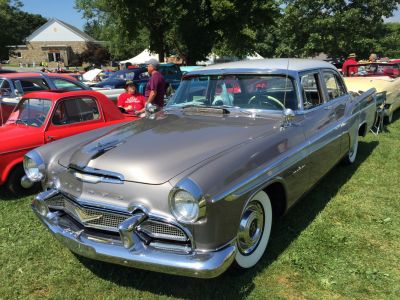
| Production: | 1955-1956 |
|---|---|
| Model Year: | 1956 |
| Length: | 5535 mm217.9 in |
| Width: | 1989 mm78.3 in |
| Height: | 1539 mm60.6 in |
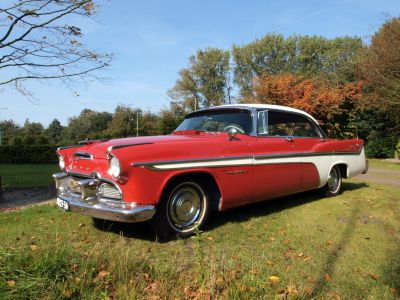
| Production: | 1955-1956 |
|---|---|
| Model Year: | 1956 |
| Length: | 5535 mm217.9 in |
| Width: | 1989 mm78.3 in |
| Height: | 1539 mm60.6 in |
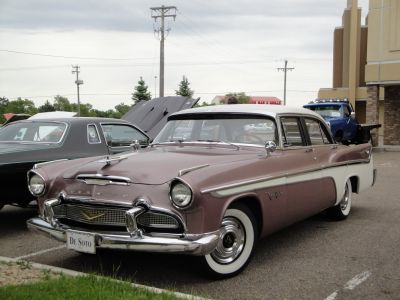
| Production: | 1955-1956 |
|---|---|
| Model Year: | 1956 |
| Length: | 5535 mm217.9 in |
| Width: | 1989 mm78.3 in |
| Height: | 1539 mm60.6 in |
